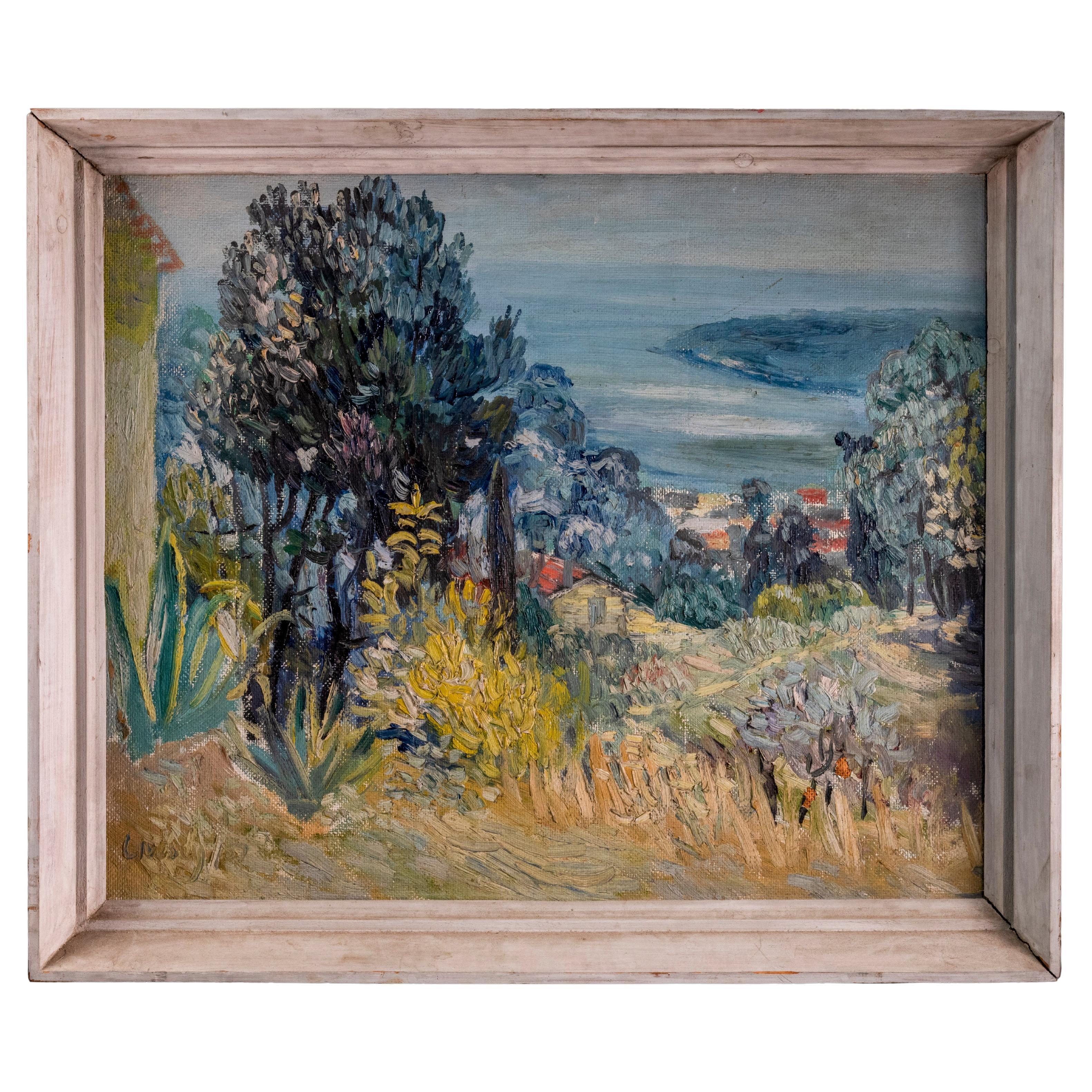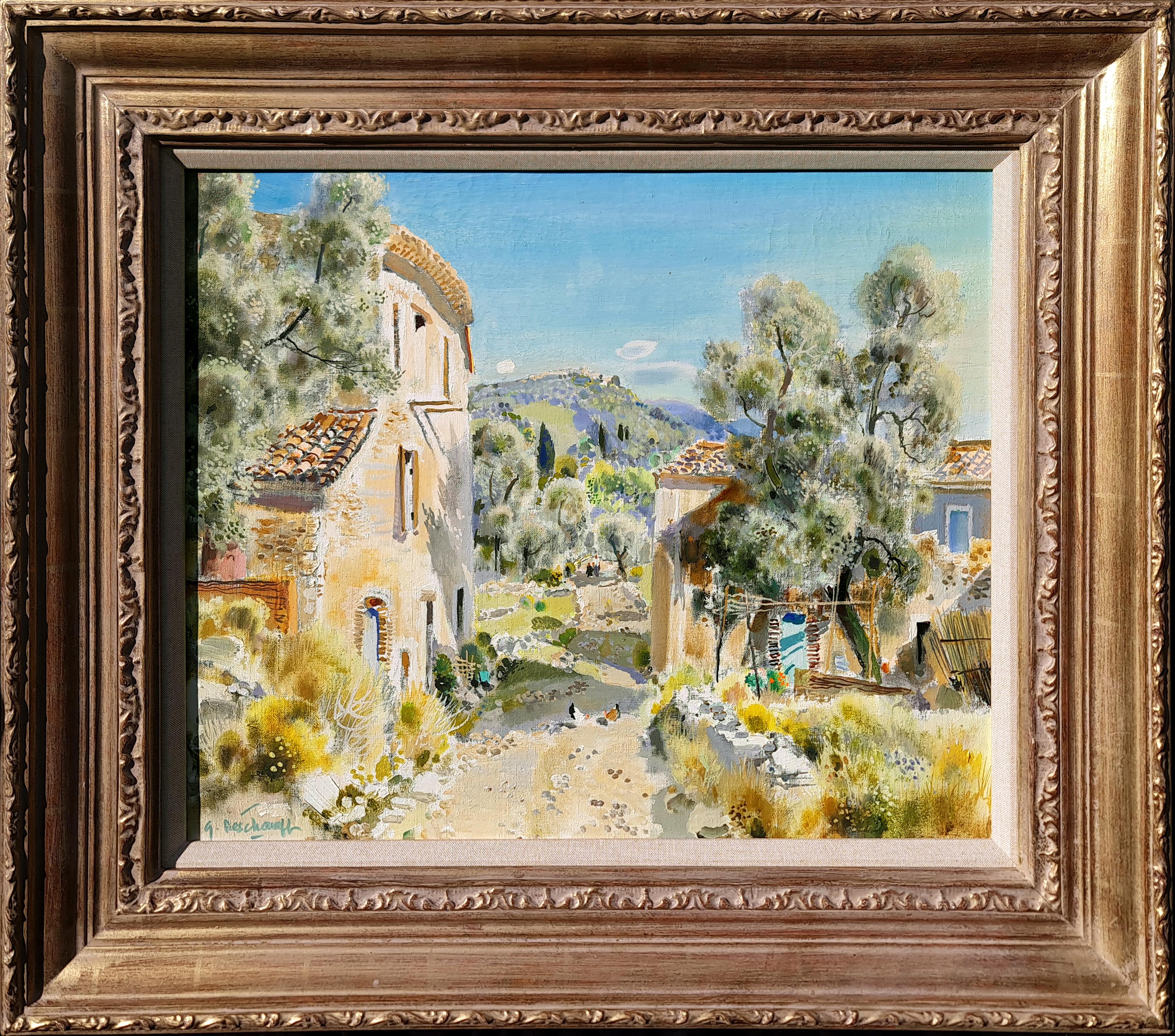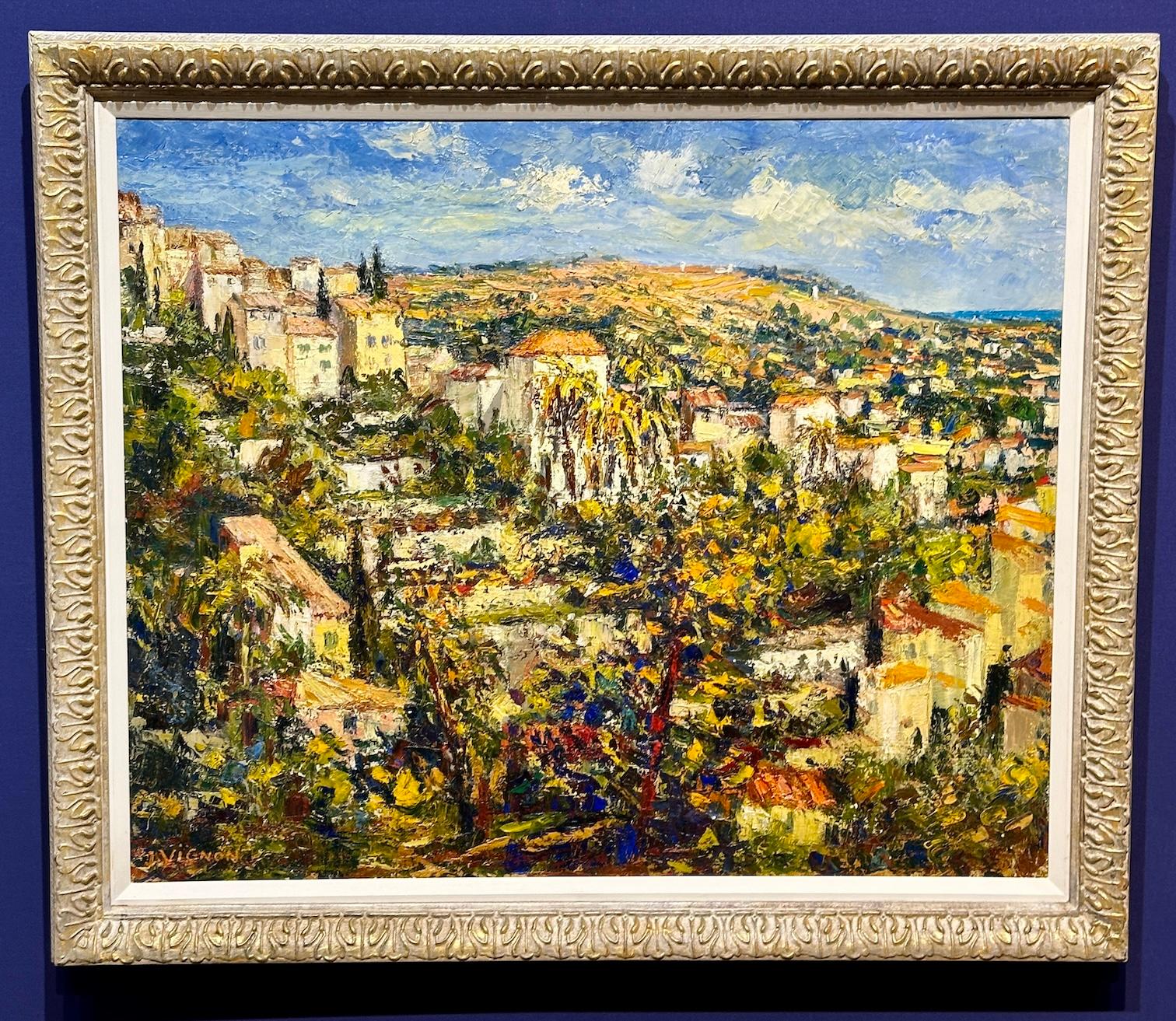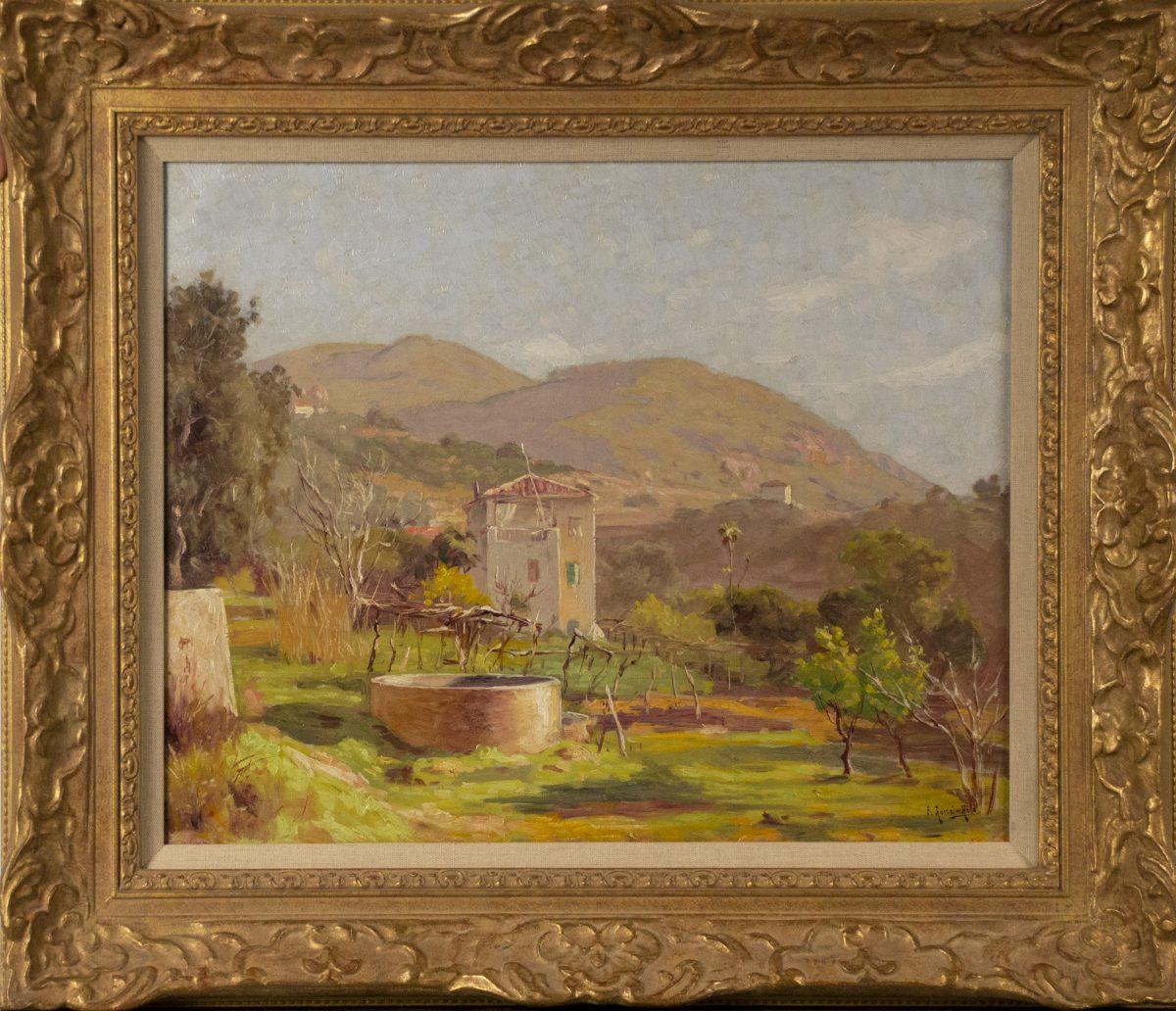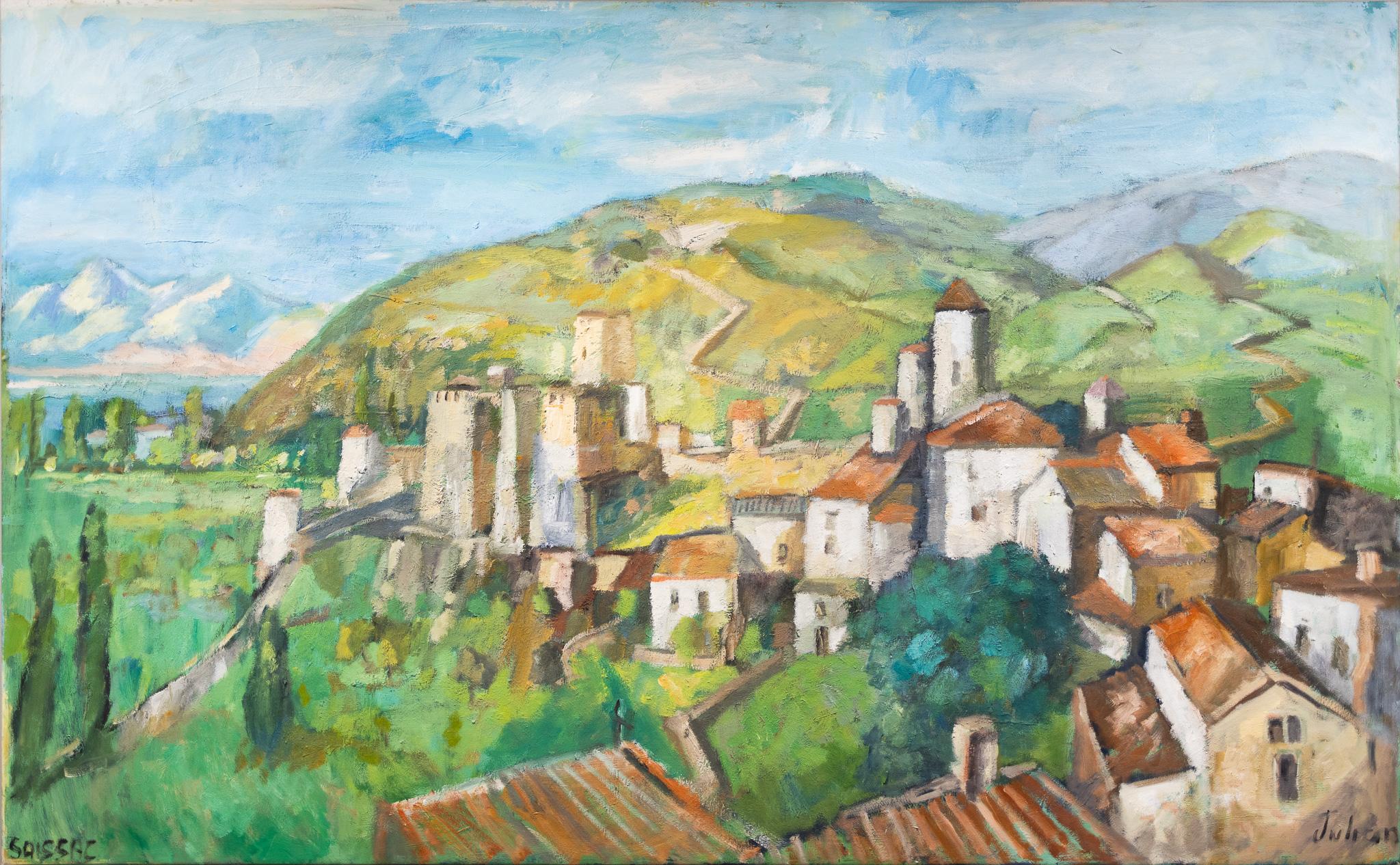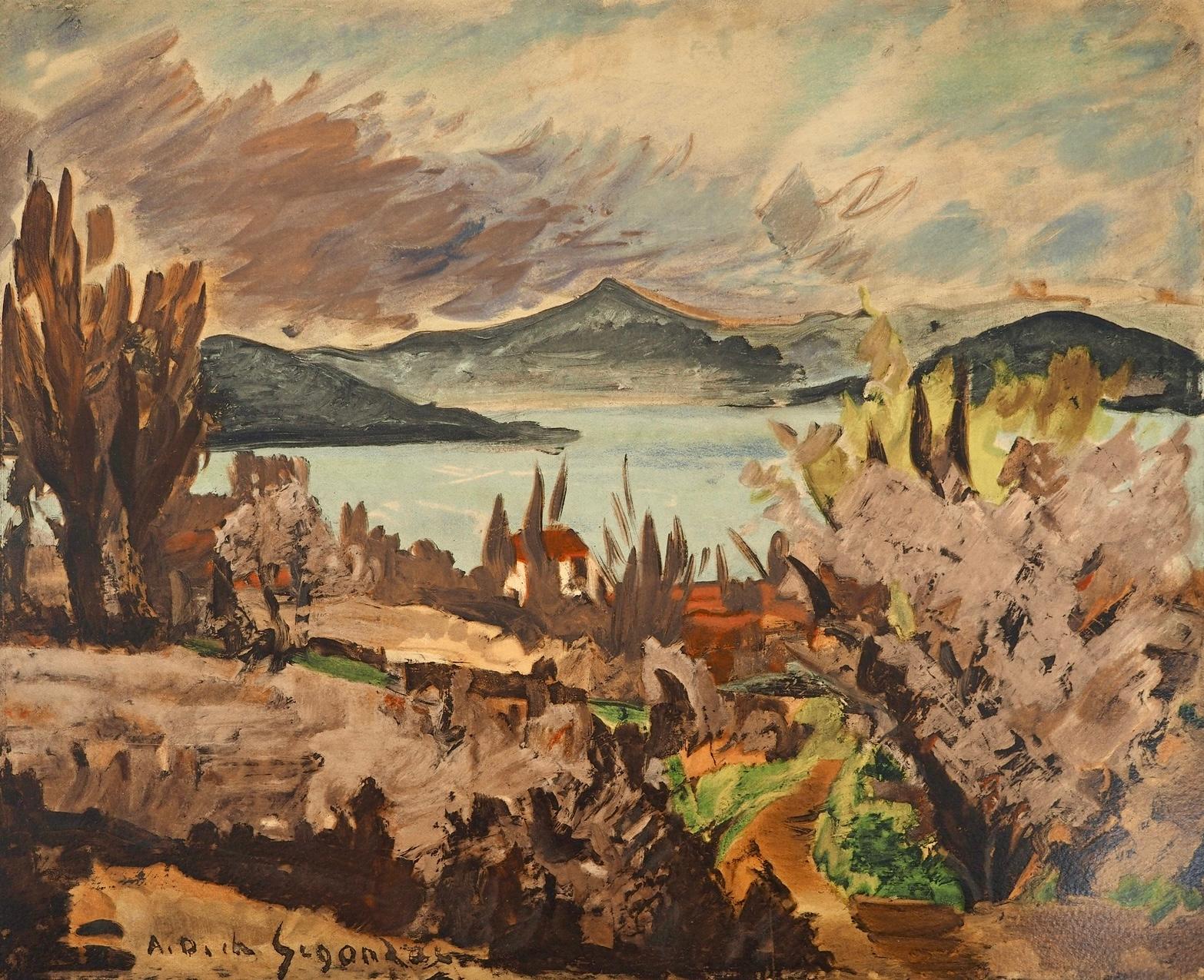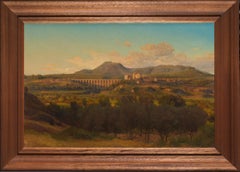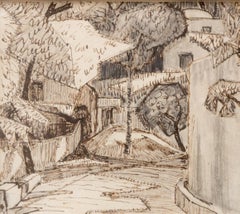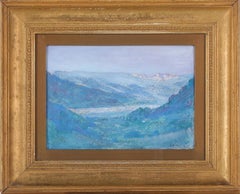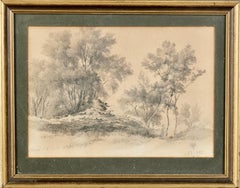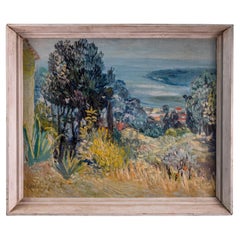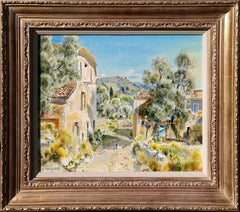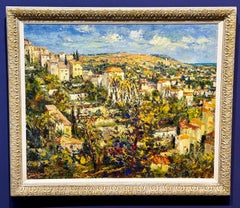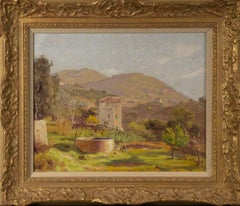Items Similar to French Riviera Landscape, Cagnes, Haut-de-Cagnes.
Want more images or videos?
Request additional images or videos from the seller
1 of 10
Frans BergFrench Riviera Landscape, Cagnes, Haut-de-Cagnes.1922
1922
$2,182.51
$3,117.8730% Off
£1,623.56
£2,319.3830% Off
€1,820
€2,60030% Off
CA$2,988.60
CA$4,269.4230% Off
A$3,322.91
A$4,747.0230% Off
CHF 1,735.04
CHF 2,478.6330% Off
MX$40,447.94
MX$57,782.7730% Off
NOK 22,138.38
NOK 31,626.2530% Off
SEK 20,742.60
SEK 29,632.2930% Off
DKK 13,854.65
DKK 19,792.3630% Off
Shipping
Retrieving quote...The 1stDibs Promise:
Authenticity Guarantee,
Money-Back Guarantee,
24-Hour Cancellation
About the Item
An impressionistic portrayal of the village of Haut-de-Cagnes on the French Riviera, painted in vibrant colors. Oil on panel, signed and dated "F Berg 22", later frame. A tergo inscribed Cagnes 1922.
Frans Johan Vilhelm Berg (1892–1949) was a Swedish painter, graphic artist, and printmaker.
After completing his high school education in 1911, Berg initially pursued studies in languages and art history at Lund University. However, an exhibition of 19th-century French art in Copenhagen left a profound impact on him, prompting him to abandon academia in favor of a full-time artistic career. He began studying etching under Axel Tallberg in Stockholm but soon shifted to painting, training under Carl Wilhelmson from 1914 to 1915. From 1916 to 1918, he continued his studies at Valand Academy in Gothenburg under Birger Simonsson.
During the summers that followed, Berg spent time on the Swedish west coast alongside prominent artists such as Birger Simonsson, Sigurd Möller, Gösta Sandels, Sigfrid Ullman, Artur Percy, and Carl Ryd.
In 1919, Berg participated in the major Skåne Artists' Exhibition at Liljevalchs in Stockholm, where he presented 20 paintings. This exhibition marked a breakthrough for him, earning critical acclaim. Art critic Andreas Lindblom described Berg’s style as:
"A fresh breeze—rich but never crude in color. Cézanne and Gauguin have undoubtedly influenced this style."
In the spring of 1920, Berg traveled to France, where he joined a community of Swedish artists in Carrières-sur-Seine, including Torsten Palm, Victor Axelson, Ullman, and Möller. His works from this period include impressionistic landscapes, still lifes, and village scenes. He particularly excelled in floral compositions, where he intensified his color palette, making flower paintings a central part of his artistic practice alongside landscapes.
Berg held solo exhibitions in Gothenburg (1917), Ystad (1934, 1938), and Malmö (1935). In 1950, a memorial exhibition was held in Ystad to honor his work.
Museum Collections
Frans Berg's works are included in several notable museum collections, including:
Moderna Museet, (Modern Museum of Art), Stockholm – "Provencal Landscape" (1921) and "Landscape from Cagnes" (1927)
Malmö Museum
Prince Eugen's Collection
Ystad Museum
Kristianstad Museum
Lund University Art Museum
Southeastern Skåne Museum of Art, Tomelilla
Berg's art, deeply influenced by post-impressionism and colorist traditions, continues to be appreciated for its vivid palette and expressive compositions.
The historic village of Cagnes, also known as Haut-de-Cagnes, is a medieval hilltop settlement overlooking the French Riviera. Dating back to the 14th century, it was built around the Château Grimaldi, a fortress that later became a Renaissance-style residence. The village’s narrow, winding streets and stone houses reflect its rich past, offering a glimpse into traditional Provençal life. In the early 20th century, Haut-de-Cagnes became a haven for artists and writers, drawn by its picturesque scenery and unique atmosphere. Today, it remains a well-preserved historic site, known for its stunning views, charming squares, and cultural heritage.
About the Seller
5.0
Vetted Professional Seller
Every seller passes strict standards for authenticity and reliability
1stDibs seller since 2023
20 sales on 1stDibs
Typical response time: <1 hour
- ShippingRetrieving quote...Shipping from: Stockholm, Sweden
- Return Policy
Authenticity Guarantee
In the unlikely event there’s an issue with an item’s authenticity, contact us within 1 year for a full refund. DetailsMoney-Back Guarantee
If your item is not as described, is damaged in transit, or does not arrive, contact us within 7 days for a full refund. Details24-Hour Cancellation
You have a 24-hour grace period in which to reconsider your purchase, with no questions asked.Vetted Professional Sellers
Our world-class sellers must adhere to strict standards for service and quality, maintaining the integrity of our listings.Price-Match Guarantee
If you find that a seller listed the same item for a lower price elsewhere, we’ll match it.Trusted Global Delivery
Our best-in-class carrier network provides specialized shipping options worldwide, including custom delivery.More From This Seller
View AllItalian Landscape, Ariccia and The Alban Mountains
Located in Stockholm, SE
View of the Ariccia Bridge and the Alban Hills
This finely executed plein air landscape depicts the monumental bridge of Ariccia and the town with the surrounding Alban Hills, painted by German landscape artist Joachim Ludwig Heinrich Daniel Bünsow (born 1821 in Kiel, died 1910 in the same city). Executed in oil on paper mounted on cardboard, the work dates from his Italian period between 1853 and 1858. Not signed.
Bünsow received his artistic training at the Royal Danish Academy of Fine Arts in Copenhagen from 1839 to 1848, studying under Johann Ludwig Lund and Christoffer Wilhelm Eckersberg. In 1844, the Copenhagen Art Association acquired his painting "Tellingstedt in Dithmarschen." Following his studies, he traveled to Dresden, where he became associated with the circle around Johan Christian Dahl. A scholarship from the Copenhagen Academy enabled Bünsow to reside in Rome from 1853 to 1858. During this period, his landscapes evolved from the finely toned, naturalistic style of his early work to more atmospheric and idealized compositions, influenced by Louis Gurlitt.
Bünsow's early works from his time in Copenhagen are characterized by fine tonality and naturalistic rendering, reflecting the style of his teacher Christoffer Wilhelm Eckersberg. His Italian landscapes, however, exhibit a more atmospheric and idealized approach, influenced by Louis Gurlitt. Notably, Bünsow produced high-quality drawings during his time in Rome, some of which are preserved in the Kunsthalle zu Kiel.
Historical Context: The Ariccia Bridge
In the early 19th century, the local authorities sought to improve the Appian Way's safety and accessibility. The solution involved constructing bridges to span the Ariccia valley and adjacent ravines. In 1843, Pope Gregory XVI commissioned a six-arched bridge to address the elevation differences. Following his death in 1846, Pope Pius IX continued the project, entrusting architect Ireneo Aleandri with the design and Giuseppe Bertolini with the execution.
Completed in 1854, the bridge stands as a significant 19th-century engineering achievement. Featuring three tiers of elegant neoclassical arches inspired by Roman art, it measures 59 meters in height and 312 meters in length. Travertine columns at both ends commemorate the Roman milestones...
Category
1850s Other Art Style Landscape Paintings
Materials
Paper, Oil, Cardboard
Positano
Located in Stockholm, SE
Ink and watercolor drawing by Carl Palme, dated 1921 and signed "CP," captures the narrow alleys of Positano. According to a note on the reverse, it is a study for an oil painting measuring 70x60 cm. Works from the early 20th century by Carl Palme are rare, making this piece particularly significant.
Drawing 20x24cm. With frame 34x36cm
Carl Adolf Palme (1879 – 1960) was a Swedish painter, draftsman, printmaker, and author. Born in Stockholm to bank director Henrik Palme and Anna Lavonius, he grew up on the Svalnäs estate, which is now a guest home and senior residence.
Palme's artistic education began in London at the Slade School of Fine Art (1900–1901). He then studied at Wassily Kandinsky's art school in Munich from 1902 to 1904. In 1907, he moved to Paris and became the first Swedish student of Henri Matisse. Palme was instrumental in founding the Académie Matisse, a collective of young Swedish and Norwegian artists who rented a large studio in Paris. Matisse visited weekly to critique their work. This group included notable artists such as Isaac Grünewald, Sigrid Hjertén, and Einar Jolin...
Category
1920s Other Art Style Landscape Drawings and Watercolors
Materials
Paper, Ink, Watercolor
Mountain and Lake View, Gruyères
Located in Stockholm, SE
A watercolor depicting a mountain view and the lake Gruyère, (Lac De La Gruyère) in Switzerland by the American Impressionist and Tonalist Mary Rogers Williams (1857–1907). Signed M.R. Williams. On the verso, the artist wrote: ‘Painted in Gruyère July 1902.’ This is a newly discovered work by a rare woman artist who seldom appears on the art market. Small in scale, yet rich in atmosphere, power, and depth—a genuine little gem.
Mary Rogers Williams was born in 1857, in Hartford, Connecticut, the fifth of six children to a local baker. Orphaned by the age of fourteen, she pursued art with remarkable determination, studying at Hartford’s Decorative Art Society and the Art Students League in New York under William Merritt Chase. Her early mentor was James Wells Champney.
In 1888, she joined Smith College as associate professor of art, where she taught for nearly twenty years to help support her family. Alongside her academic career, she maintained a serious and evolving artistic practice, though much of it was pursued within the limitations of her era’s gender roles and financial pressures.
Her work is often classified as a blend of Tonalism and Impressionism—movements that were just taking shape during her lifetime. Tonalists used subdued palettes to evoke mood rather than detail, while Impressionists leaned toward brighter colors and broader subjects. Williams, working independently of art-world factions, forged a style rooted in mood, light, and atmosphere. She painted luminous pastels, watercolors, and oils—portraits, landscapes, and intimate studies of daily life.
Despite knowing figures like Whistler, William Merritt Chase, and Childe Hassam, she rarely aligned herself with any artistic “school” and found many male contemporaries pretentious or repetitive. She famously dropped out of Whistler’s Paris school, calling him “a pompous fop surrounded by fawners.” Though Mary Cassatt and Williams were both American Impressionists living in Paris, they never met—Cassatt enjoyed wealth and elite circles, while Williams was a self-reliant educator without patrons.
Williams traveled extensively throughout Europe—from the Arctic Circle to the ruins south of Naples—often alone or with her sister. She bicycled through fjords, hiked to medieval towns, and visited chateaux and harbors, all while sketching prolifically. She is likely the only 19th-century woman artist whose travels and daily life can be traced in such vivid, personal detail: what she ate, how she felt about fellow travelers, what she paid for trams, how the air smelled, what she wore, and how she missed home.
She documented everything—museum visits, church restorations, conversations with hotel guests, and her frustrations with men’s treatment of women artists. These letters, rediscovered in 2012 in a family boathouse, provide an extraordinary insight into not only her art but the intellectual and emotional texture of her life.
Her writings reveal not only artistic insight but the immense workload she carried. At Smith, she taught studio art and art history, organized faculty events, curated student exhibitions, wrote essays, handled housework, and even cooked and cleaned for her own lodgings. On vacations, she cooked for her family; in Europe, she waxed floors, painted walls, repaired clothing, and stoked fires—all while maintaining her painting and travel schedule.
Unlike many of her male peers, she had no assistants, no household staff, and little inherited wealth. Yet, as her letters reveal, she never saw herself as a victim—she relished challenges and even the absurdities of her era, from Italian waiters pushing marriage to department heads at Smith dismissing women’s artistic capacity.
Despite these challenges, Williams exhibited widely during her lifetime:
Paris Salon (1899)
National Academy of Design (1903–04)
Pennsylvania Academy of the Fine Arts
New York Water Color Club, American Water Color Society, Art Association of Indianapolis, and more.
She was praised in The New York Times, Hartford Courant, and Springfield Republican, and compared by peers to figures like Emily Dickinson—another New England woman of quiet yet profound artistic power. But unlike Dickinson, Mary Williams...
Category
Early 1900s American Impressionist Landscape Drawings and Watercolors
Materials
Paper, Watercolor, Cardboard
Narni Landscape Drawing
Located in Stockholm, SE
“Hilly landscape with trees and bushes from Narni in Italy,” sketched by Gustav Wilhelm Palm (1810–1890). Dated and signed “Narni 16 Sept” with “G.W [palm tree] 45,” it portrays gent...
Category
1840s Other Art Style Landscape Drawings and Watercolors
Materials
Paper, Pencil
Mountain Winter Landscape
By Anselm Schultzberg
Located in Stockholm, SE
A quiet mountain winter landscape called "Winter road" or as it is written on the back in Swedish "Vinterväg" and “Vinterlandskap from Granberget at Rämen, Värmland", Gran-mountain ...
Category
Early 19th Century Other Art Style Landscape Paintings
Materials
Canvas, Oil
Mountain Landscape, Northern Sweden, Oil on Panel.
Located in Stockholm, SE
A mountainous landscape painted by Hilding Elof Nyman (1870 - 1937). Oil on panel. The motif is probably from Dalarna in Swedens north part were he spent periods of his life. Nyman ...
Category
Early 20th Century Impressionist Landscape Paintings
Materials
Oil, Panel
$527 Sale Price
60% Off
You May Also Like
Modern Signed Painting French Riviera Landscape
Located in Roma, IT
Wonderful mid-century signed painting oil on canvas by a French artist
Title “View of Menton Cap Martin”
It depicts a beautiful view of the French Riviera, in particular Cap Martin-...
Category
Early 20th Century Modern Landscape Paintings
Materials
Oil, Panel
$1,403 Sale Price
35% Off
En Provence
By Gabriel Deschamps
Located in Belgravia, London, London
En Provence
by Gabriel Deschamps
French 1919 - 2011
Oil on canvas
Canvas size: 18 x 21.75 inches
Framed size: 26 x 29.5 inches
Signed lower left
Category
20th Century Post-Impressionist Landscape Paintings
Materials
Canvas, Oil
$20,224
French Impressionist South of France Landscape with hill top Village
By Josine Vignon
Located in Woodbury, CT
Josine Vignon (1922-2022) was a French artist living on the Rue Beautreillis in the Marais district of Paris. She painted with a beautiful style, largely influenced by the Impression...
Category
1950s Landscape Paintings
Materials
Canvas, Oil
Mountain Landscape, Col de Villefranche, South of France
By René Charles Edmond His
Located in West Sussex, GB
Rene Charles Edmond His
(1877 – 1960) French
Col de Villefranche, South of France
Oil on canvas: 13x16 in. (Frame: 20x23in.) Signed& inscribed ...
Category
Early 20th Century French School Landscape Paintings
Materials
Oil
"Saissac" Impressionist Landscape of Southern French Commune
Located in Austin, TX
By Julian Petrie
This painting depicts the French commune Saissac in Southern France.
48" x 77.5" Oil on Canvas
Category
20th Century Impressionist Landscape Paintings
Materials
Canvas, Oil
de Segonzac, Golfe de Saint-Tropez, Collection Pierre Lévy (after)
By André Dunoyer de Segonzac
Located in Fairfield, CT
Medium: Lithograph on vélin d'Arches paper
Year: 1967
Paper Size: 20 x 26 inches
Inscription: Signed in the plate and unnumbered, as issued
Notes: From the folio, Dunoyer de Segonzac...
Category
1960s Modern Landscape Prints
Materials
Lithograph
$716 Sale Price
20% Off
More Ways To Browse
Renaissance Flower Painting
Chateau Panel
French Village Etching
Etching Medieval
19th Century Oil Paintings Swedish
1920 Oil Painting Floral
Percy Gray
Artist Percy Gray
Oil Paintings By Percy
Carl Wilhelmson
Japanese Farm
Joseph Banks
Memento Mori Painting
Michael Klein
Romanesque Art
Vintage Water Tower
William Hart
19th Century Moon Painting
